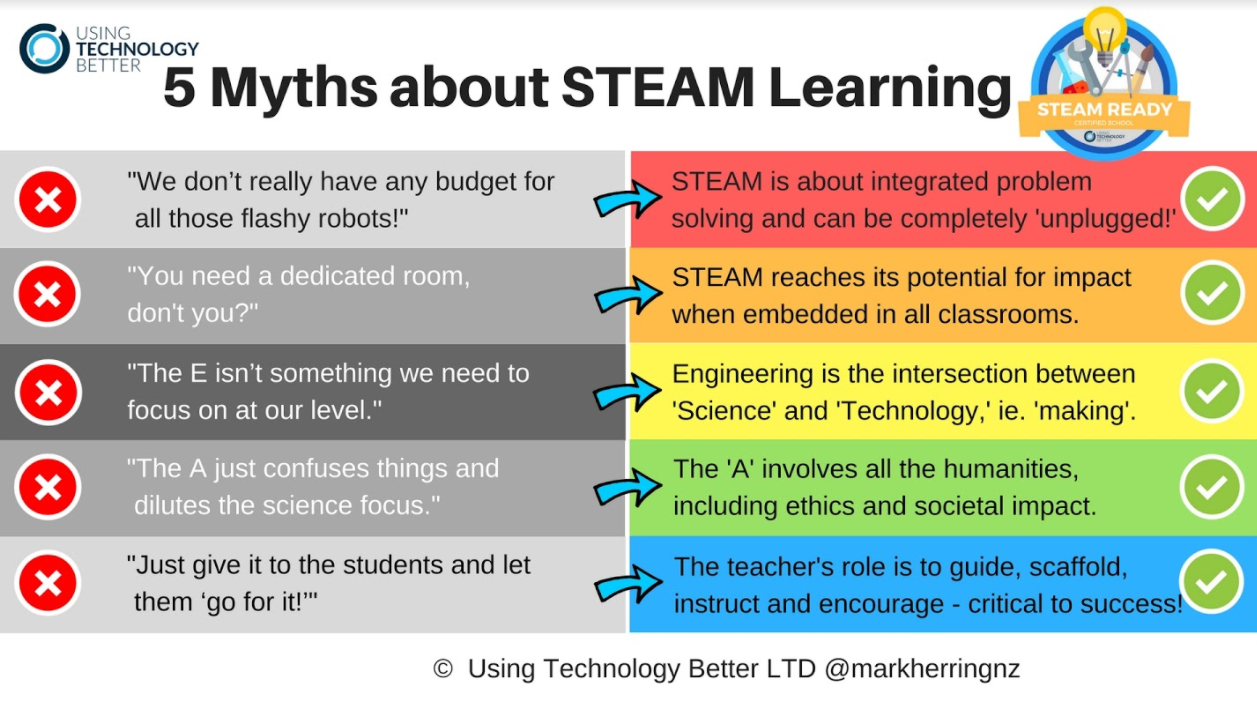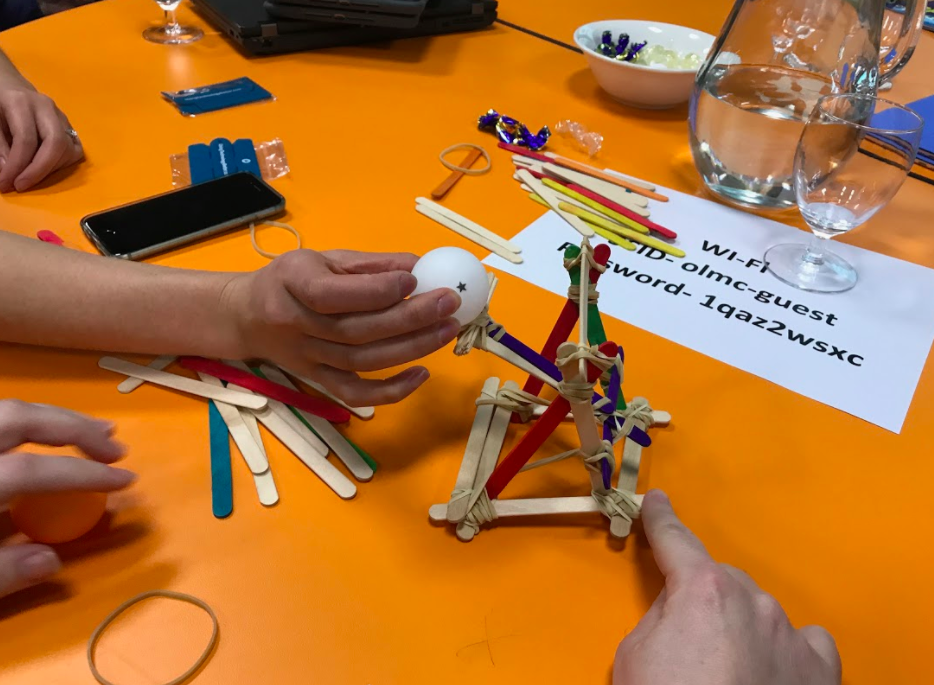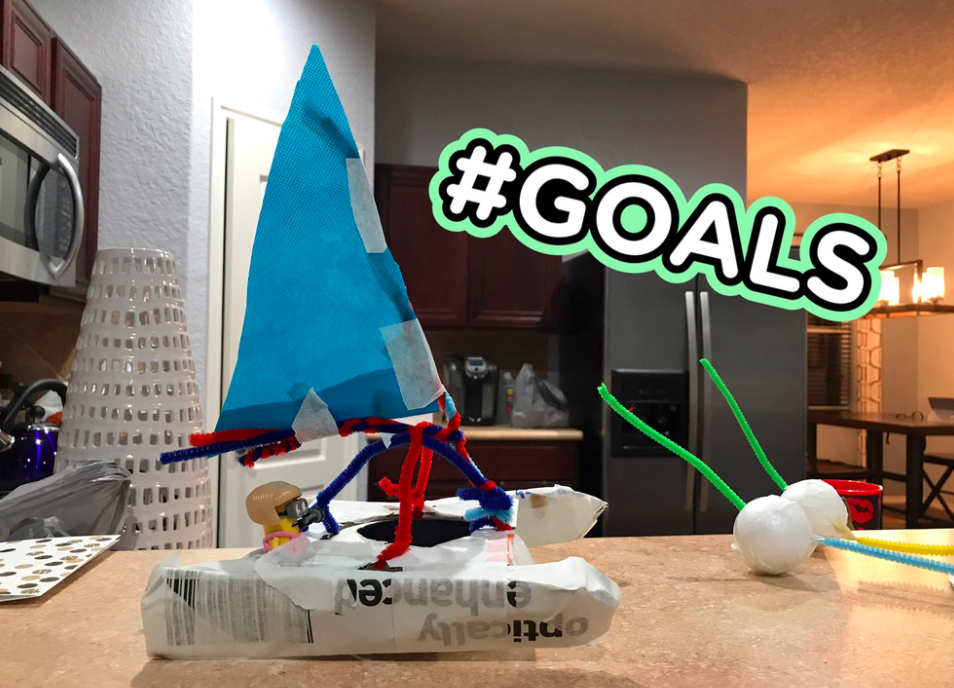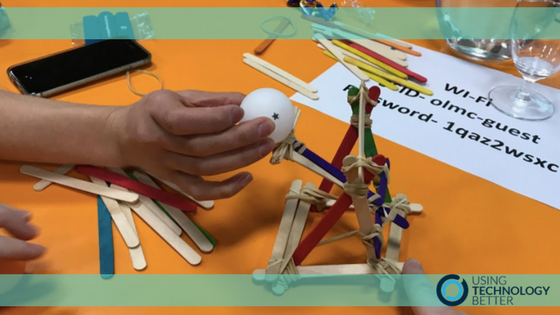STEM and STEAM would be one of the biggest buzz words going around education at the moment. Many schools are wanting to engage their students with this approach to learning.
[bctt tweet=”All I do is put the gear on the table and let the students go for it!” See why this is just one of 5 big myths about STEAM learning.” username=”markherringnz”]
As UTB’s Lead STEAM Trainer, I talk with teachers and principals all over the world about the benefits and challenges of integrating STEAM. But there are also lots of misconceptions about what it is and how to implement it effectively.
Here is a list of the 5 most commonly held myths I often hear about STEAM Learning.

1. We don’t really have any budget for all those flashy robots
The most common complaint from school leaders is how expensive the STEAM equipment can be to purchase. In many people’s minds, the way to get STEAM humming in classrooms is to buy the flashiest, shiniest new toys and tools. Sadly, If you go to any conference or STEAM workshop, that’s what STEAM is held up as being all about.
The danger with this approach is that teachers disregard the learning pedagogy that STEAM relies on. The best way to get the most out of STEAM is to have students collaborating and seeking to solve real-world, authentic problems.
In my experience, the shiny new tech tools can often become a hindrance as the focus becomes the tool and not the process. It’s as silly as builders running around firing their new nail guns into the wood, and thinking that they’re actually building.

So how do you avoid this mistake in your school?
When we start our STEAM workshops we always focus on the pedagogy first, and then experience and unpack that understanding with very ‘low tech’ challenges. These usually involve cups, popsicle sticks and very cheap materials. You could even run a fantastic STEAM challenge at the beach with driftwood.
The movie ‘Castaway’ is full of authentic STEAM problem solving as the main character strives to survive and improve his life on the island. In an essence, this is what STEAM is all about – solving people’s problems. The aim is to work through the Design Thinking Process, and do it over and over again until you succeed. You don’t need a robot to do that!
2 .You need a dedicated room
There are too many schools spending vast amounts of money on dedicated rooms and spaces for their STEAM programs. I’m a huge advocate for having room to create, setup and store STEAM projects.
However, the danger with these ‘maker spaces’ is that they risk becoming the latest version of the 1990’s computer lab, where the use of this powerful approach to learning is isolated from everyday learning and becomes something that we only do when we go to the STEAM space. It also gives the majority of teachers the license to avoid integrating STEAM, since that is what the ‘STEAM teacher does’ when the class goes to the maker space.
[bctt tweet=”We’ll put lots of robotics gear into a room and call it ‘The STEAM Room. That’ll get our school humming with STEAM.” username=”markherringnz”]
STEAM can be done in any room, with any tools and in any environment.
There are some spaces that make it easier or more manageable, but this is not absolutely necessary and can easily be more detrimental to widespread school STEAM integration.
3. The E isn’t something we need to focus on
It’s very easy for us to see STEAM through the lens of our traditional curriculum areas. Engineering can easily be seen as something that students will explore when they reach tertiary level study, or get into the trades.
However, in essence, engineering is a way to describe the designing and making aspect of a STEAM project. It can be seen as the intersection of our science understanding and what we know as technology. This is something a 5 year old will do when they are building with lego or constructing a bridge out of newspaper.
There are also specific engineering principles we can teach students through STEAM.
There are four forms of engineering:
- Chemical,
- Civil
- Electrical
- Mechanical
All of these disciplines have a body of knowledge that teachers can plan for and enable their students to explore and discover.
Having this understanding as a teacher is why professional development and teacher experience is crucial to successful STEAM learning in your school.

4. The A just confuses things
This is something I hear from people across all levels of our school system. Some principal’s are well-meaning in wanting to focus on the Science and Technology development for their teachers, while Secondary teachers often like to focus on their speciality area of subject-based expertise.
Both of these people will state that a focus on integrating the visual arts will dilute the emphasis on the STEM areas.
However, in many minds, the ‘A’ includes far much more than the aesthetic or emotive features of a solution to a need or a want. If you unpack what the arts are, you realise that it includes all of the humanities subjects.
These involve the social impact of products and processes, including their ethics and ways that humans interact with designs.
A recent example of this includes the controversy of how Facebook is being used to influence ideas and the spread of misinformation. Some would argue that the lack of consideration and thought into the ‘A’ in STEM is a growing concern for our modern society. I think that we disregard the ‘A’ to our peril.
5. Just give it to the students and let them ‘go for it!’
This is what I often hear when teachers and leaders are lacking the knowledge of a new tool or product themselves. There’s no doubt that the curious nature and ‘give it a go’ attitude of many younger learners will keep them engaged for a while. However, it’s only a matter of time before that engagement will start to wain and boredom will kick in. For most students, this strategy only works for a limited amount of time before they get distracted or disinterested.
The role of the teacher and their understanding of a tool’s limitations and strengths is critical for getting the most from the STEAM learning approach. A teacher’s goal should be to develop the 6Cs of;
- creativity,
- collaboration,
- critical thinking,
- global connections,
- character,
- citizenship.
To do this effectively, students need a teacher’s understanding of a tool to help them problem solve, be inspired, and have the possibilities modelled to them.
A teacher doesn’t need to be an expert with the tools, but they at least need to know the basics to help frame a student’s thinking in the right direction and to be able to model or ‘think aloud’ when appropriate.

STEAM learning is an incredible new approach to making learning real for our students, in a way that enables them to be as ‘future ready’ as they can be.
If you’re interested in attending one of our STEAM Ready workshops, click here for the latest dates coming up near you.
[bctt tweet=”Dedicated STEAM rooms can be come today’s equivalent of the computer lab in the 1990s.” username=”markherringnz”]
We also offer schools more comprehensive support to help develop their STEAM programs, including support for every teacher in every class. Click here to find out about our STEAM Ready Schools Program, and here for our STEAM Ready Certified Trainer Program. We’d love to partner with you and your school soon!

















